Harnessing smart solar tracking: advanced algorithms for hail protection
Empowering solar arrays with intelligent responses to extreme weather.
Hail is an atmospheric phenomenon difficult to predict and highly destructive due to the large size hailstones can reach. That large size and high velocity of hailstones can cause severe damages to most constructions.
Hail is produced by the presence of convective air currents in which large masses of moisture-laden air, after being pushed up by warm air to high and cold layers of the atmosphere, cool very quickly before solidifying and giving rise to hailstones, the size of which is hard to predict as it depends on the merging between warm and cold air currents.
Every year, hailstorms cause great damage worldwide due to their destructive force. Just in the United States alone, this weather phenomenon resulted in construction-related losses exceeding $1 billion (ref. 1) in 2021.
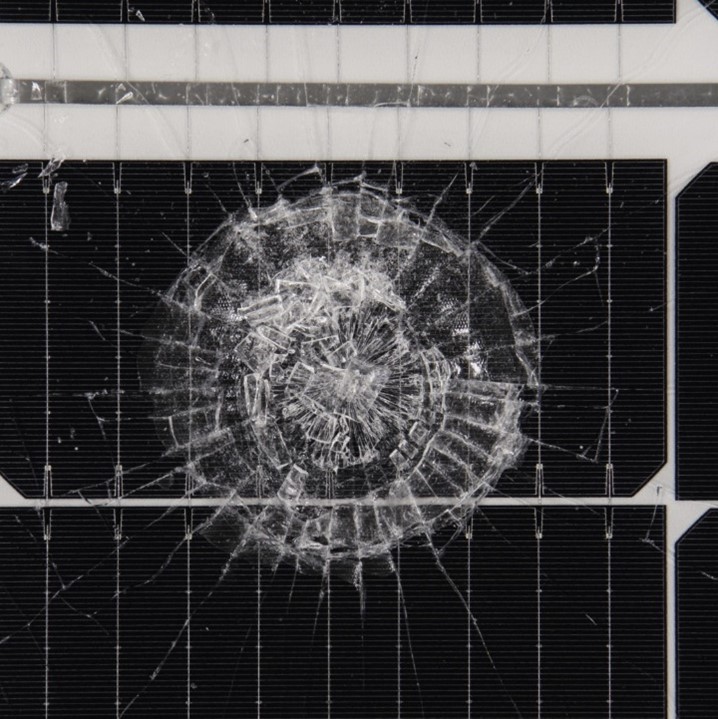
In the case of solar plants, the high hardness of materials used to build the frontside of solar modules, is beneficial against damages such as abrasion, but it also results in high brittleness and makes modules highly susceptible to impact-induced damages. Although it is becoming increasingly common for modules to be certified (IEC 61215) against the impact of hailstones with a diameter of up to 25mm (terminal velocity), there are many world areas where the average diameter of hail is greater than this value.
This problem makes it necessary to protect modules against hail, especially considering the considerable economic losses it can cause.
The layout of fixed solar panels does not provide an efficient stow strategy against this problem, as shown in Figure 2. On the contrary, solar trackers are able to adapt to hail storms, thus reducing the potential impact on photovoltaic power plants, where damages could be just as catastrophic as in fixed structures, as shown in Figure 3.
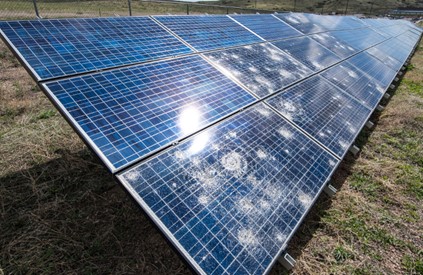

Some world areas have little or no exposure to hail. On the contrary, in other parts of the world the frequency and intensity of hailstorms makes it necessary to take into account these weather events and to adopt measures mitigating their impact. Figures 4 and 5 reveal that the central strip of the USA is an area quite prone to hailstorms, with data showing that in this strip, the diameter of hailstones is well above the photovoltaic module certification value. Similarly, Figure 6 shows the European areas most affected by +20mm hailstones.
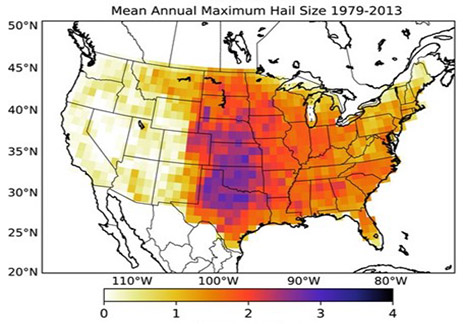
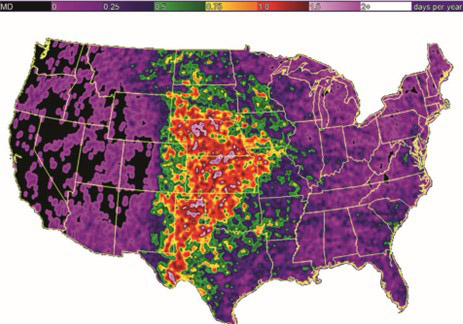
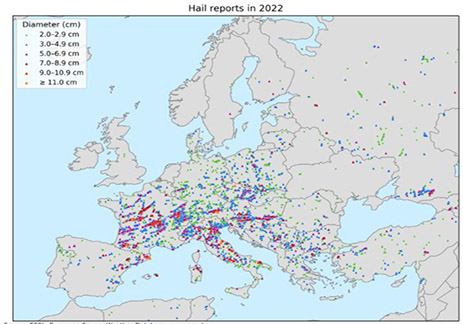
Module damages due to hailstone impact are caused by kinetic energy dissipation (resulting from hail mass and terminal velocity in free fall) on the front glass of the module.
Any action favoring a decrease of the energy amount to be dissipated by the module due to hail impact, will result in a reduced risk of module damage.

Taking hailstone velocity as a vector, it is easy to deduce that any action aimed at increasing inclination between this vector and the normal module surface vector, favors a reduction in module damage because impact-related kinetic energy is also reduced. Thus, the most favorable panel position is that in which the normal direction is perpendicular to hail direction. Figure 7 shows that for a module with a tilt of 0° in relation to the Y axis, the normal module vector coincides with the Z axis, which means that the entire energy of a hailstorm falling with an inclination of 90° in relation to the Y axis, will dissipate on the module surface. On the other hand, if module tilt is 55°, then the normal module vector will no longer coincide with the hailstorm direction, and therefore impact-related energy will not be completely dissipated on the module.

In ideal weather conditions without wind, the hail velocity vector would only have a vertical component. However, as mentioned at the beginning of this paper, when it hails there are usually strong wind currents which influence the hail velocity vector, causing hailstones to also have a horizontal velocity component. This implies that the most favorable module position to mitigate hail effects is not totally vertical, but with a certain tilt angle in relation to the vertical plane.
Figure 8 shows how, due to the horizontal velocity component of hailstorms, the velocity vector inclination, in this case 55° in relation to the Y-axis, can become completely perpendicular to the normal module surface vector, thus minimizing hailstone impacts and in turn panel damage. In this case, even if hailstone impacts occurred, the energy to be dissipated would be minimal.

Although data on hailstone impact angles is scarce, some numerical models are useful to calculate impact angles based on some common hailstorm parameters. Figure 9 shows data from one of these models, revealing that 25-50mm hailstones, which have a diameter sufficient to damage photovoltaic modules and are much more frequent than hailstones larger than 50mm (as seen in Figures 4 and 5), usually have a tilt ranging from 55° to 70° in relation to the horizontal plane.

Since hailstorms are a brief, one-off meteorological phenomenon, the strategy to minimize hail damage is based on two main aspects:
Hailstorms are rapid weather phenomena with a typical duration of no more than 15 minutes.
Although many weather services issue warnings about hailstorms, and the plant operator always has the option of manually taking the plant to a hail stow position, damages caused by hailstorms can happen so fast that it is paramount to have a fast, reliable and dedicated detection system. In that sense, our hail stow system is equipped with specific hail detection sensors which are used in parallel to weather forecasts. This is certainly a significant advantage compared to manually triggered systems, as it provides an early warning.
Once an alert is received, Soltec’s algorithm adjusts the hail stow mode based on wind speed, a response which also favors tracker return to its tracking position upon detection that the alert has passed.

The system responds promptly with the aim of reducing module exposure to hail impacts. Given the rapid evolution of hailstorms, it is necessary to have quick activation mechanisms, as that is an advantage when it comes to damage prevention. In the case of Soltec, our fast motor, with a final rotation speed of 20°/min, allows us to quickly position solar trackers in their hail defense position.
This position typically corresponds to the maximum tracking angle opposite to the wind direction, as seen in Figure 8. Like this, the panel frontside is less exposed to the oblique trajectory of hailstones, whereas the rearside is also protected as it is not in a completely vertical position.
Trackers with a wind stow position similar to the hail stow position, as is the case with Soltec trackers, have an additional advantage because, as mentioned before, hail storms are usually associated with strong winds.

In the event of a hailstorm, photovoltaic modules in their hail stow position (inclined with their normal vector as perpendicular as possible to the hail direction), have a lower exposed surface area than modules not moved to a specific stow position. Consequently, the former receive less hailstone impacts than the latter. If hail velocity vector inclination is equal to stow position tilt, the percentage of impacts can be negligible. As for Soltec, the stow position tilt of our tracker (55°, optional 60°) coincides with the most common inclination of 25-50mm hailstones (Figure 9), which means it also provides good protection against the most common inclination of hail measuring more than 50mm. The following tables show the exposed module surface for different module tilt and hail direction values.
| Stow angle | Hail angle | % Exposed surface area |
|---|---|---|
| 0 | 90 | 100% |
| 30 | 90 | 87% |
| 55 | 90 | 57% |
| 60 | 90 | 50% |
| Stow angle | Hail angle | % Exposed surface area |
|---|---|---|
| 0 | 75 | 97% |
| 30 | 75 | 71% |
| 55 | 75 | 34% |
| 60 | 75 | 26% |
| Stow angle | Hail angle | % Exposed surface area |
|---|---|---|
| 0 | 60 | 87% |
| 30 | 60 | 50% |
| 55 | 60 | 9% |
| 60 | 60 | 0% |
In addition, this tilt in relation to the hail fall means the module will have to dissipate less kinetic hailstone energy. The following tables show the energy percentage to be dissipated by modules due to the impact of a 25-mm hailstone at terminal velocity:
| Impact with the module at 0ª | |
|---|---|
| Hailstone size (mm) | Kinetic energy to be dissipated as per test IEC 61215 |
| 25 | 100% |
| 50 | 1650% |
| 75 | 8690% |
| Impact with the module at 55ª | |
|---|---|
| Hailstone size (mm) | Kinetic energy to be dissipated as per test IEC 61215 |
| 25 | 33% |
| 50 | 540% |
| 75 | 2860% |
| Impact with the module at 55ª and hail impacting at an angle of 75º | |
|---|---|
| Hailstone size (mm) | Kinetic energy to be dissipated as per test IEC 61215 |
| 25 | 12% |
| 50 | 190% |
| 75 | 2860% |
| Impact with the module at 55ª and hail impacting at an angle of 60º | |
|---|---|
| Hailstone size (mm) | Kinetic energy to be dissipated as per test IEC 61215 |
| 25 | 0% |
| 50 | 4% |
| 75 | 22% |
This reduces the risk of catastrophic module damage due to hailstone impact on their frontside, mainly as a result of both an exposed area reduction and a lower dissipated energy, two factors potentially lowering hail damage risk by 50% when hailstone size ranges between 50-75mm, and practically eliminating damage depending on hail inclination.
Solar tracking plants in world areas exposed to hailstorms should feature a hail stow algorithm to minimize potential damage to modules. In the case of Soltec, this algorithm is based on our experience in combating adverse weather conditions in solar plants around the world.
As indicated throughout this paper, damage can be catastrophic and result in a major impact, both in terms of replacement of damaged modules, but also of power plant production losses. Therefore, it is important to have an early detection stow system equipped with sensors, as well as to equip trackers with a prompt response mechanism moving them to the best position, which is not always vertical as it depends on wind speed and direction at any given time.
Although it is difficult to estimate the economic value of potential generation losses if trackers are not positioned in a hail stow angle, as such value depends on the actual damage caused, it is more than necessary to equip solar plants with prevention methods against phenomena which can damage them.
ref. 1 https://www.pv-magazine.com/2023/08/09/hail-prone-areas-may-require-solar-modules-with-4-mm-thick-front-glass/
ref. 2 https://www.solarpowerworldonline.com/2020/12/can-your-solar-project-weather-a-hailstorm/
ref. 3 https://www.renewableenergyworld.com/solar/solar-farm-pelted-by-giant-hail-as-severe-storm-ripped-through-nebraska/#gref
If you want to collaborate with us or need more information about Soltec you can contact us at any of our offices around the world.
Nuestro conocimiento y experiencia a través del análisis e investigación en los principales temas del sector.
